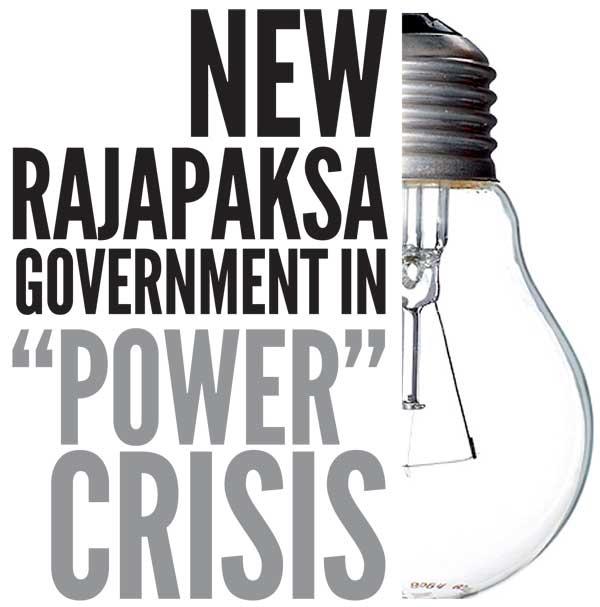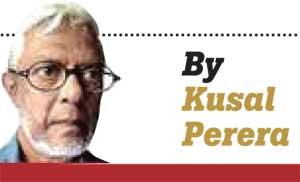Reply To:
Name - Reply Comment
With no clear plan approved so far to sustainably increase power generation within a year, where will Sri Lanka be with all promises for new development?
“Since 2011, over 700 renewable energy projects totalling 2,400 MW, had been stalled due to opposition in the CEB” read a news report, quoting sources at a meeting the new Minister of  Power and Energy Mahinda Amaraweera had with top officials of the Ceylon Electricity Board and the ministry, last week.
Power and Energy Mahinda Amaraweera had with top officials of the Ceylon Electricity Board and the ministry, last week.
This year, another 80 such renewable energy projects with a total capacity of over 450 MW had not been approved. It is said, CEB engineers were of the opinion, these solar and wind power projects cannot be added to the national power grid as the national grid is now at optimum use.Wonder if anyone had queried from the CEB, how emergency power supplies that’s purchased even without proper tenders are distributed if the national grid cannot accommodate anymore from renewable energy generations. There is certainly a major crisis brewing, not because we lack resources but because we are burdened with heavy corruption that denies proper planning and efficient execution.
Power and energy sector is a lucrative sector for those who engage in policy and decision making and in procurement. It is said a unit of electricity from wind power is bought by the CEB for Rs.22 when its actual market price is around Rs.12 and 14. The production cost per unit does not exceed Rs.08 say professional sources. Creating situations to purchase emergency power has lately become the more profitable manipulation for decision makers and their political allies. In early this year, the cabinet decision to allow purchase of emergency power from a Turkish company at a higher rate than that of negotiated prices of Rs.28 and 30 per Kw with British and Hong Kong companies is just one instance.This year’s loss to CEB would be around 85 billion rupees, mostly due to purchase of emergency power.
This ad hoc approach in getting about “power crises” due to neglect of proper planning by the CEB officials and the ministry of power and energy, also has other added factors that go without much attention. One major contributor to this power crisis is the UDA. Every building constructed would eventually increase regular consumption of electricity if not during the whole day, then at least for a period of about 10 hours in the night.Thus, how buildings are added to urban and suburban areas also decide how much electricity is consumed, though with no consultations with CEB about available capacities.
UDA has sole authority in providing approval to all constructions on land above 40 perches, with floor space of over 4,000 sq. feet and also construction of more than 04 storeys, with Local Government (LG) bodies robbed of their legitimate right to govern and administer the area demarcated as under their powers. Municipalities, Urban Councils and Pradeshiya Sabhas under relevant LG Authority Acts are held responsible for streets, drains, sewerage systems, conservancy and cleanliness, public markets, cemeteries, prevention of nuisance, removal of insanitary, overcrowded and ruinous buildings and also construction of buildings. In short, it is the LG body that is responsible for public health, comfort and convenience of its “Rate payers”.
All of it is now left at the mercy of the UDA. What urban development means is value adding to urban space, other than by agriculture and horticulture activities. This has no planning in real life. With more areas declared “urban” when the minister feels they are, UDA is reduced in practice to granting approval to construction. Approvals are merely about adding value to urban land space with parcelling out and construction of buildings that can generate income. Quite recently, PM Mahinda Rajapaksa’s observation that some powers of the UDA in approving building plans should be given back to LG bodies saw grumbling and resentment from UDA officials.They claimed, LG bodies are not automated to handle such work and thereby adding more paperwork would make cumbersome work out of it, leading to delays and corruption.
These explanations by UDA tend to make people believe that with the wholly automated UDA in control, urban construction today is without corruption, does not run into delays and is well planned and very efficient. If one wishes to see the status of urban planning and construction under the UDA, one is advised to make a journey from Kollupitiya to at least Mt. Lavinia on the Galle Road.
"This year’s loss to CEB would be Rs. 85 bn, mostly due to purchase of emergency power"
 Umpteen numbers of multi storey apartments have mushroomed along narrow streets that hardly allows two trishaws to pass each other. Parking space for these apartments have been either overlooked in the plan or the construction is outside the plan, compelling vehicles to be parked on the street. So are approvals given for commercial establishments. Large sales-outlets have been approved in most inappropriate locations that contribute to and create unwanted traffic jams. Some commercial establishments have turned out as a total nuisance to long-time residents in the area.
Umpteen numbers of multi storey apartments have mushroomed along narrow streets that hardly allows two trishaws to pass each other. Parking space for these apartments have been either overlooked in the plan or the construction is outside the plan, compelling vehicles to be parked on the street. So are approvals given for commercial establishments. Large sales-outlets have been approved in most inappropriate locations that contribute to and create unwanted traffic jams. Some commercial establishments have turned out as a total nuisance to long-time residents in the area.
How such massive numbers of apartments and commercial establishments allowed in an urban area would impact on responsibilities charged with municipalities and urban councils such as streets, drains, sewerage systems, conservancy and cleanliness and also public nuisance have not been any concern to the UDA in providing approval. That visual impact in Colombo and suburbs prove automation in UDA has little relevance to ratepayers and to those who are regular visitors to these urban areas. They also say, these would not be there as eye sores, if UDA was a clean and an efficient State authority.
In a similar manner, increase in consumption of electricity perhaps is not accounted for in UDA approvals. UDA may not know what capacity the air-conditioners installed in these large mushrooming apartments and commercial establishments are and what their consumption of electricity is. So are lifts used and lighting in such large constructions. Even if they are included in individual plans, it is impossible to believe the UDA has the cumulative quantity of electricity consumed in apartments and commercial establishments they approved in a year. There is therefore a serious deficiency in actual data for future planning that goes with “estimates” calculated on previous numbers.
Added are massive projects, both solicited and unsolicited that governments negotiate and accept as foreign aid and grants. Colombo Port City that began construction after its work was stalled with the change of government in January 2015, issued a statement that had mention of power distribution networks in Colombo the Chinese Harbour Engineering Company said, “……capacity for the Colombo power network will be doubled through a new 220kV underground transmission cable network ….. Further, the project would improve the existing power network by construction of four new grid substations, augmentation of the existing grid substations, laying of 37.7 km of underground transmission cables, laying 92 km of underground distribution cables and an installation of 86 new 11 kV distribution panels.” This was in reference to a loan agreement the GoSL had entered into with JICA to improve power requirements in Greater Colombo area.
Does it say anything about new or additional power generation? The statement says the CEB had agreed to construct a “500 MVA primary substation at Chaitya Road” and to allocate 250 MVA to the Port City.Since this statement in December 2016, the Colombo Port City now renamed as “Colombo International Financial City” was declared to have a new investment of 01 billion US dollars last year for construction of three massive 60 storey buildings, that is to attract more investment for more infrastructure. These 60 storey buildings will all have central air conditioning and numerous other power consuming factors, all through day and night. What would their consumption of power be, if in full utility? There is also a Chinese project that constructs a 22 storey building for the Colombo National Hospital that would have 4,500 beds for an emergency treatment unit. How much power would such a high-end medical treatment complex need for its daily services?
All these heavy power consumers with equally heavy power consumers like the Shangri la, the ITC Colombo One Hotel and Residences, would in all probability double the power consumption in the Greater Colombo and Colombo Business District by the end of year 2020.
With no clear plan approved so far to sustainably increase power generation within a year, where will Sri Lanka be with all promises for new development?
While the new government sort out its strategy in meeting an inevitable power crisis in 2020 or 2021, the UDA can reduce the burden on the national grid, by laying down clear instructions and conditions for present and future constructions in Greater Colombo and the Colombo Business District. One is to provide a grace period of 01 year to the 05 Municipal Councils in Colombo District to switch all street lighting to solar power. Perhaps the government could offer assistance to such a project as future investment. The UDA can lay down a mandatory condition to investors on commercial establishment to have solar power and provide 01 year for existing commercial establishments to switch to solar power. That would ease the burden on the national grid and allow some space for CEB to get its act together, before Sri Lanka goes through blackouts and power cuts with many in the power industry blaming each other.